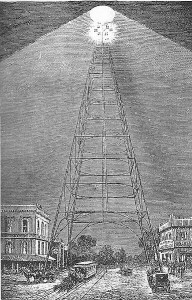 Every era has technological innovations that seem significant at the time (and sometimes are) but somehow slip out of the history books to fade from the collective memory. During research for the second novel in my Reeferpunk series, I found one of these innovations too irresistible to pass up. From the late 19th century to the early 20th century moonlight towers illuminated cities across both Europe and the United States.
Every era has technological innovations that seem significant at the time (and sometimes are) but somehow slip out of the history books to fade from the collective memory. During research for the second novel in my Reeferpunk series, I found one of these innovations too irresistible to pass up. From the late 19th century to the early 20th century moonlight towers illuminated cities across both Europe and the United States.
While these towers populated dozens of cities for almost half a century, illuminating city blocks with powerful arc lamps, they quickly dimmed into history’s forgotten archives. Bizarre to the modern eye, these towers often ranged from 150 to over 200 feet high and were used during an era when standard, smaller-sized street lamps were impractical and readily-available electricity had yet to burgeon.
Controversy around the towers ranged from practical to comical. In Austin, Texas, citizens feared the towers would result in a breed of mutant vegetables and crops that grew day and night. People reportedly held concerns that animals wouldn’t sleep and that roosters would deafen citizens with incessant crowing.
While the towers faded from use by the 1930’s in almost every city across the world, they remain in use in one modern city–Austin. Purchasing 31 towers from Detroit in 1894, Austin endeavored to upgrade their backwater reputation to that of a modern capital city.
Each tower used six carbon arc lights and illuminated more than two city blocks. Using hydro-electricity from Austin Damn the nighttime hours of the up-and-coming city were bathed in a pale-blue light. Over the years the installation of the towers in Austin has been attached to the case of the Servant Girl Murders that later became known as the Servant Girl Annihilator.
An interesting anecdote on its own, these serial murders happened in 1885, three years before Jack the Ripper. There were 16 known victims, seven murdered. Happening almost ten years earlier than the installment of the towers, the actually connection between the murders is weak.
Remarkably, the towers remained in constant use despite the loss of the damn in 1900, the switch to incandescent lamps in the 20’s and to mercury vapor lamps in the 30’s. The towers were nearly removed during WWII in order to comply with the need to black out the city quickly in case of an air raid. But at the last minute the installation of a central switch allowed the towers to be shut off citywide.
Seventeen towers remain in Austin today. In 1993 each tower was disassembled and restored in its entirety, and they are now protected by city ordinances and recognized as Texas State Landmarks. Their mercury vapor lamps are visible from several miles away.
In my novel, The Austin Job, I of course took some liberties in creating a lore and conspiracy around the construction of the towers and had some fun using them to drizzle the nighttime streets of Austin with a creepy atmosphere that hopefully adds to the overall effect of the story. Once again, the blending of fact and fiction captivated and inspired me as the discovery of a single historical blip shaped the novel into something no doubt more quirky and fun than without.[divider]
The whole experience begs the question, what other bits of dieselpunk history and lore remain obscured and waiting to be dusted off and re-envisioned?